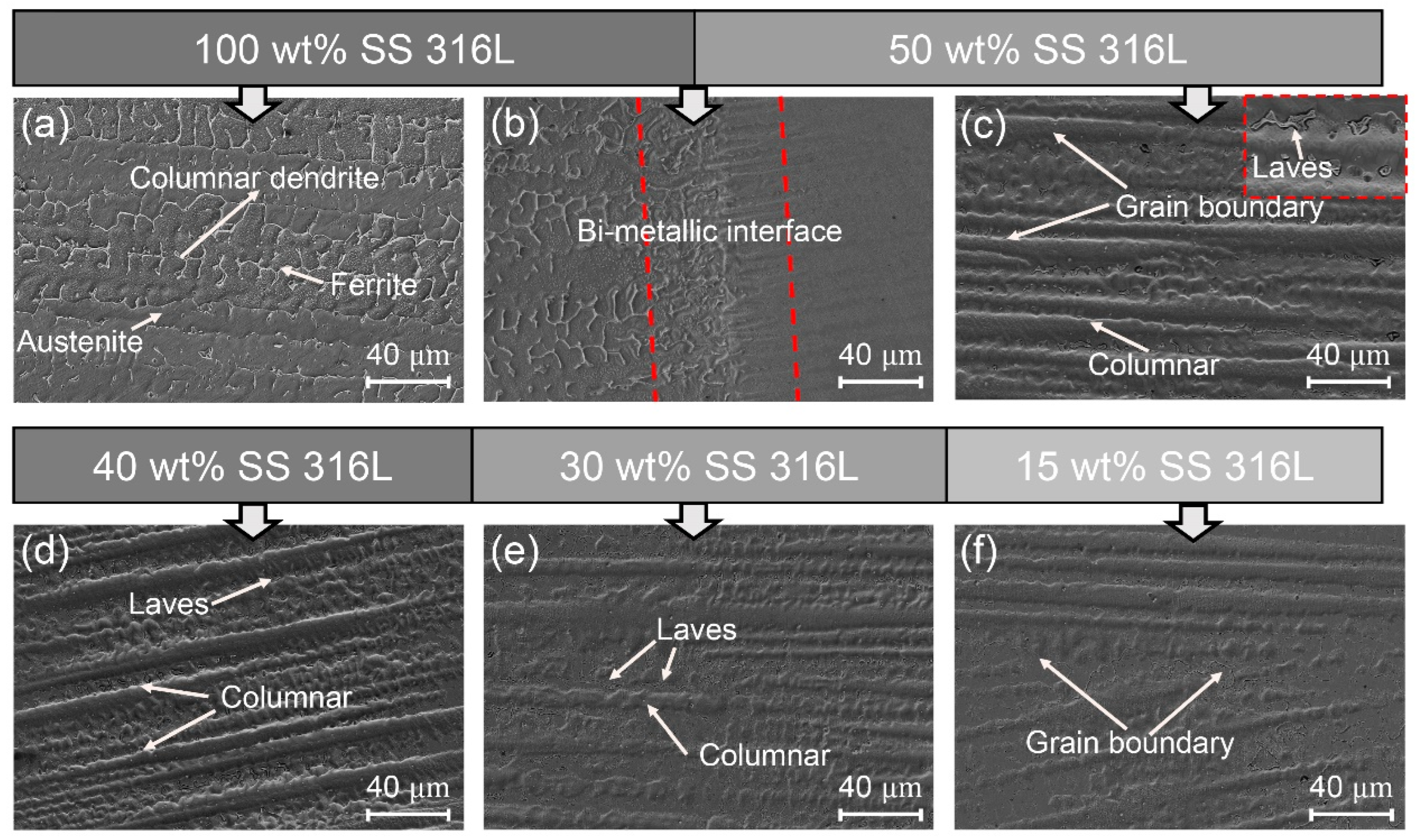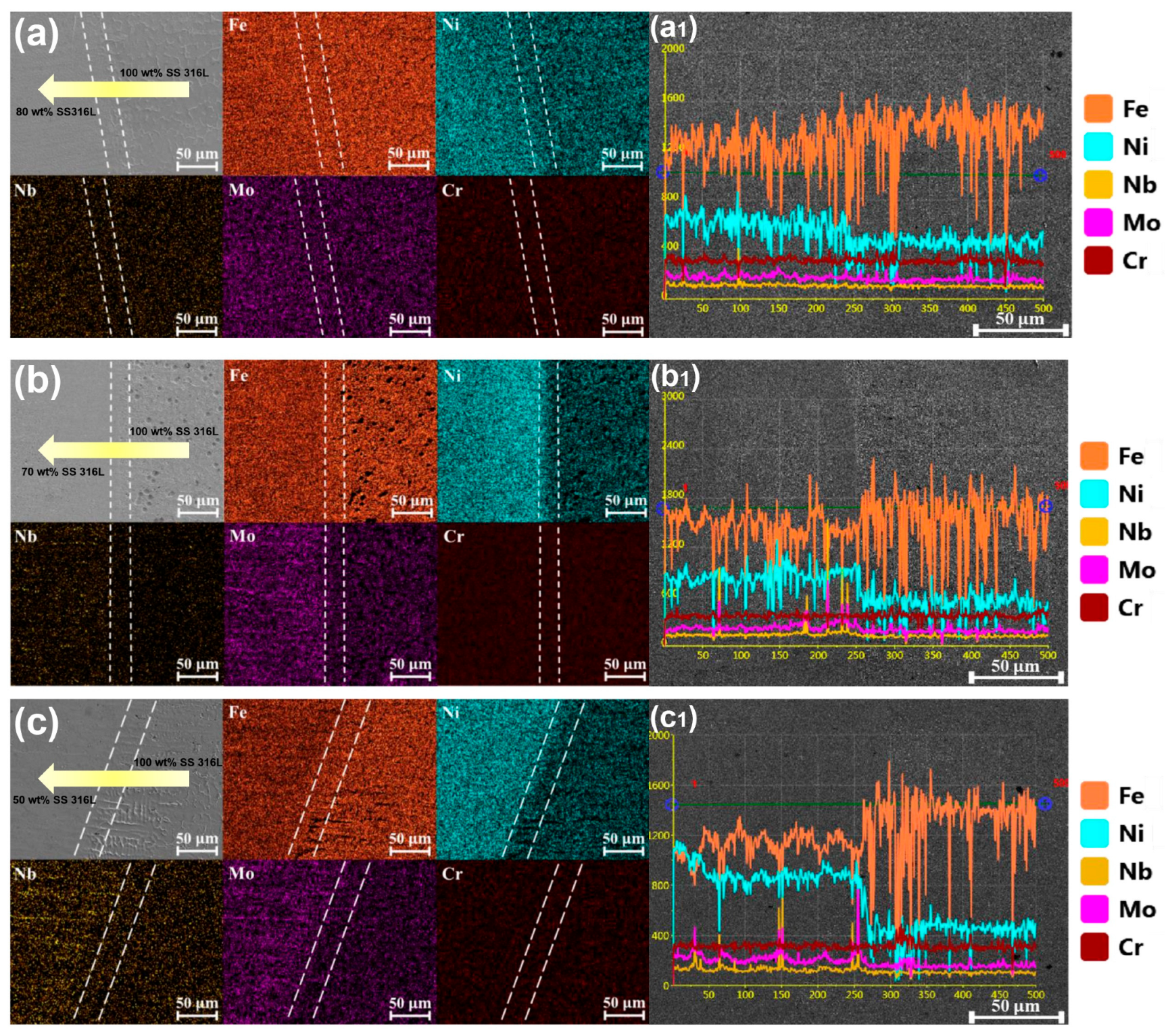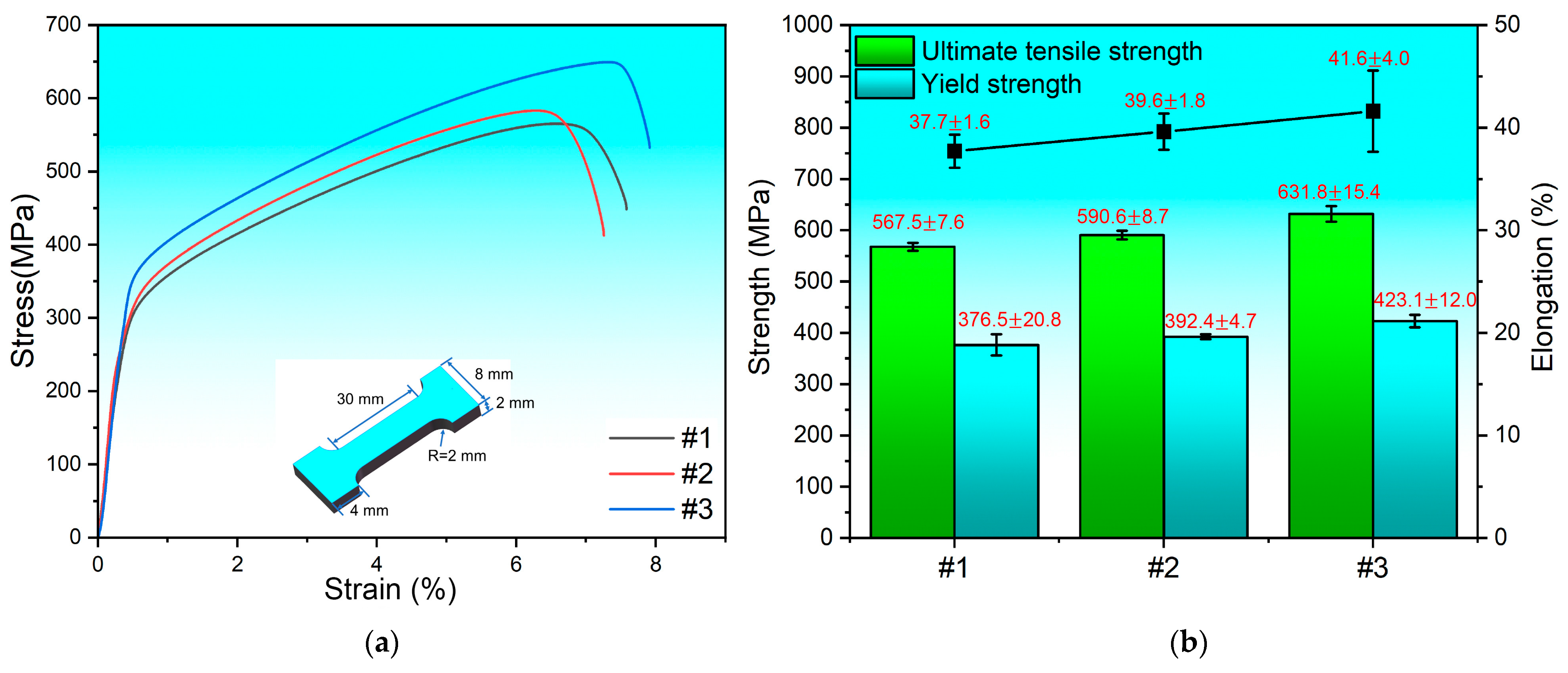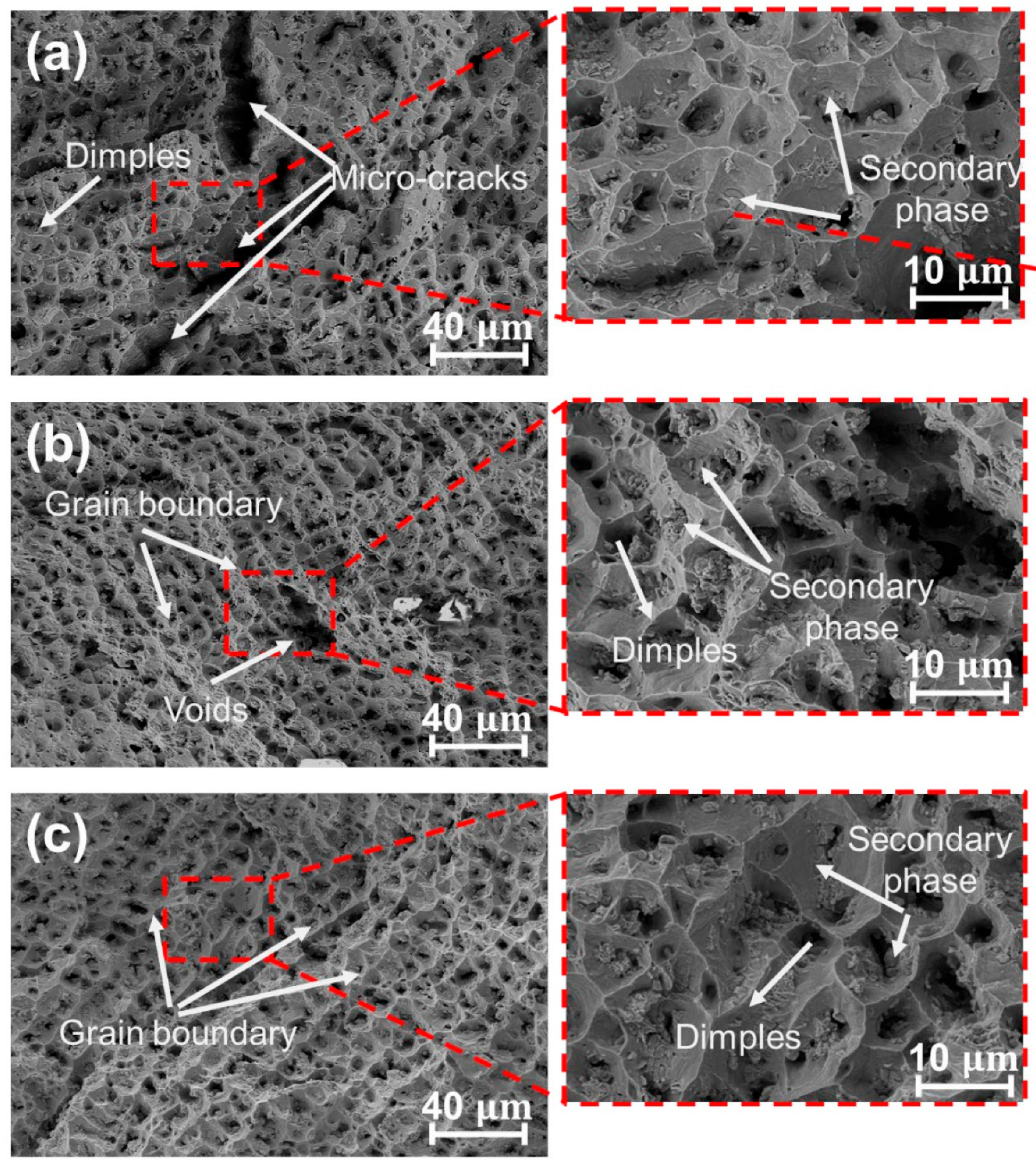Study on Optimization Strategy for the Composition Transition Gradient in SS 316L/Inconel 625 Functionally Graded Materials
Abstract
1. Introduction
2. Materials and Methods
3. Results
3.1. Microstructure
3.2. Composition Distribution
3.3. Mechanical Properties
3.3.1. Microhardness
3.3.2. Tensile Properties
4. Conclusions
Author Contributions
Funding
Institutional Review Board Statement
Informed Consent Statement
Data Availability Statement
Conflicts of Interest
Abbreviations
| Abbreviations | |
| WAAM | Wire Arc Additive Manufacturing |
| FGMs | Functionally Graded Materials |
| AM | Additive Manufacturing |
| LMD | Laser Metal Deposition |
| D-WAAM | Dual-Wire Arc Additive Manufacturing |
| EDM | Electrical Discharge Machining |
| Symbol | |
| Density of SS 316L | |
| Density of Inconel 625 | |
| The diameter of SS 316L | |
| The diameter of Inconel 625 | |
| The wire feed speeds of SS 316L | |
| The wire feed speeds of Inconel 625 | |
References
- Jo, M.; Kim, H.S.; Park, J.Y.; Lee, S.G.; Kim, B.J.; Kim, H.C.; Ahn, Y.S.; Kim, B.; Kang, N.; Nam, D. Microstructure and Mechanical Properties of P21-STS316L Functionally Graded Material Manufactured by Direct Energy Deposition 3D Print. Metals 2022, 12, 2086. [Google Scholar] [CrossRef]
- Kuffner, B.H.B.; Capellato, P.; Ribeiro, L.M.S.; Sachs, D.; Silva, G. Production and Characterization of a 316L Stainless Steel/β-TCP Biocomposite Using the Functionally Graded Materials (FGMs) Technique for Dental and Orthopedic Applications. Metals 2021, 11, 1923. [Google Scholar] [CrossRef]
- Zhang, J.; Di, X.; Jiang, X.; Li, C. Effect of synchronous electromagnetic stirring on Laves phase morphology and mechanical property of Inconel625-HSLA steel functionally graded material fabricated by wire arc additive manufacturing. Mater. Lett. 2022, 316, 132015. [Google Scholar] [CrossRef]
- Yang, S.W.; Yoon, J.; Lee, H.; Shim, D.S. Defect of functionally graded material of Inconel 718 and STS 316L fabricated by directed energy deposition and its effect on mechanical properties. J. Mater. Res. Technol. 2022, 17, 478–497. [Google Scholar] [CrossRef]
- Kim, S.H.; Lee, H.; Yeon, S.M.; Aranas, C.; Choi, K.; Yoon, J.; Yang, S.W.; Lee, H. Selective compositional range exclusion via directed energy deposition to produce a defect-free Inconel 718/SS 316L functionally graded material. Addit. Manuf. 2021, 47, 102288. [Google Scholar] [CrossRef]
- Oliveira, J.P.; Shamsolhodaei, A.; Shen, J.; Lopes, J.G.; Gonçalves, R.M.; de Brito Ferraz, M.; Piçarra, L.; Zeng, Z.; Schell, N.; Zhou, N.; et al. Improving the ductility in laser welded joints of CoCrFeMnNi high entropy alloy to 316 stainless steel. Mater. Des. 2022, 219, 110717. [Google Scholar] [CrossRef]
- Costa, A.M.S.; Oliveira, J.P.; Pereira, V.F.; Nunes, C.A.; Ramirez, A.J.; Tschiptschin, A.P. Ni-based Mar-M247 superalloy as a friction stir processing tool. J. Mater. Process. Technol. 2018, 262, 605–614. [Google Scholar] [CrossRef]
- Zhang, X.; Chen, Y.; Liou, F. Fabrication of SS316L-IN625 functionally graded materials by powder-fed directed energy deposition. Sci. Technol. Weld. Join. 2019, 24, 504–516. [Google Scholar] [CrossRef]
- Savitha, U.; Jagan Reddy, G.; Venkataramana, A.; Sambasiva Rao, A.; Gokhale, A.A.; Sundararaman, M. Chemical analysis, structure and mechanical properties of discrete and compositionally graded SS316–IN625 dual materials. Mater. Sci. Eng. B-Adv. 2015, 647, 344–352. [Google Scholar] [CrossRef]
- Carroll, B.; Otis, R.; Borgonia, J.; Suh, J.O.; Dillon, R.P.; Shapiro, A.A.; Hofmann, D.C.; Liu, Z.K.; Beese, A.M. Functionally graded material of 304L stainless steel and inconel 625 fabricated by directed energy deposition: Characterization and thermodynamic modeling. Acta Mater. 2016, 108, 46–54. [Google Scholar] [CrossRef]
- Su, Y.; Chen, B.; Tan, C.; Song, X.; Feng, J. Influence of composition gradient variation on the microstructure and mechanical properties of 316 L/Inconel718 functionally graded material fabricated by laser additive manufacturing. J. Mater. Process. Technol. 2020, 283, 116702. [Google Scholar] [CrossRef]
- Shah, K.; ul Haq, I.; Khan, A.; Shah, S.A.; Khan, M.; Pinkerton, A.J. Parametric study of development of Inconel-steel functionally graded materials by laser direct metal deposition. Mater. Des. 2014, 54, 531–538. [Google Scholar] [CrossRef]
- Mehrabi, O.; Seyedkashi, S.M.H.; Moradi, M. Functionally Graded Additive Manufacturing of Thin-Walled 316L Stainless Steel-Inconel 625 by Direct Laser Metal Deposition Process: Characterization and Evaluation. Metals 2023, 13, 1108. [Google Scholar] [CrossRef]
- Mohan Kumar, S.; Rajesh Kannan, A.; Pravin Kumar, N.; Pramod, R.; Siva Shanmugam, N.; Vishnu, A.S.; Channabasavanna, S.G. Microstructural Features and Mechanical Integrity of Wire Arc Additive Manufactured SS321/Inconel 625 Functionally Gradient Material. J. Mater. Eng. Perform. 2021, 8, 5692–5703. [Google Scholar] [CrossRef]
- Li, T.; Wang, Z.; Hu, S.; Yang, Z.; Wang, Y. Hot cracking during the fabrication of Inconel 625/stainless steel 308 L functionally graded material by dual-wire arc additive manufacturing. J. Manuf. Process. 2022, 82, 461–473. [Google Scholar] [CrossRef]
- Wang, F.; Williams, S.; Rush, M. Morphology investigation on direct current pulsed gas tungsten arc welded additive layer manufactured Ti6Al4V alloy. J. Adv. Manuf. Technol. 2011, 57, 597–603. [Google Scholar] [CrossRef]
- Vahedi Nemani, A.; Ghaffari, M.; Nasiri, A. On the Post-Printing Heat Treatment of a Wire Arc Additively Manufactured ER70S Part. Materials 2020, 13, 2795. [Google Scholar] [CrossRef]
- Ghaffari, M.; Vahedi Nemani, A.; Rafieazad, M.; Nasiri, A. Effect of Solidification Defects and HAZ Softening on the Anisotropic Mechanical Properties of a Wire Arc Additive-Manufactured Low-Carbon Low-Alloy Steel Part. JOM 2019, 71, 4215–4224. [Google Scholar] [CrossRef]
- Cunningham, C.R.; Flynn, J.M.; Shokrani, A.; Dhokia, V.; Newman, S.T. Invited review article: Strategies and processes for high quality wire arc additive manufacturing. Addit. Manuf. 2018, 22, 672–686. [Google Scholar] [CrossRef]
- Yu, X.Y.; Xue, J.X.; Shen, Q.K.; Zheng, Z.H.; Ou, N.; Wu, W.; Jin, L. Effect of composition gradient design on microstructure and mechanical properties of dual-wire plasma arc additively manufactured 316L/IN625 functionally graded materials. Mater. Chem. Phys. 2023, 307, 128121. [Google Scholar] [CrossRef]
- Li, T.X.; Wang, Z.J.; Yang, Z.W.; Shu, X.X.; Xu, J.; Wang, Y.; Hu, S.S. Fabrication and characterization of stainless steel 308 L/Inconel 625 functionally graded material with continuous change in composition by dual-wire arc additive manufacturing. J. Alloys Compd. 2022, 915, 165398. [Google Scholar] [CrossRef]
- Lin, X.; Yue, T.; Yang, H.; Huang, W.D. Laser rapid forming of SS316L/Rene88DT graded material. Mater. Sci. Eng. A 2005, 391, 325–336. [Google Scholar] [CrossRef]
- Zhang, W.H.; Lei, Y.L.; Meng, W.; Ma, Q.S.; Yin, X.H.; Guo, L.J. Effect of Deposition Sequence on Microstructure and Properties of 316L and Inconel 625 Bimetallic Structure by Wire Arc Additive Manufacturing. J. Mater. Eng. Perform. 2021, 12, 8972–8983. [Google Scholar] [CrossRef]
- Kong, D.C.; Dong, C.F.; Wei, S.L.; Ni, X.Q.; Zhang, L.; Li, R.X.; Wang, L.; Man, C.; Li, X.G. About metastable cellular structure in additively manufactured austenitic stainless steels. Addit. Manuf. 2021, 38, 101804. [Google Scholar] [CrossRef]
- Feenstra, D.R.; Molotnikov, A.; Birbilis, N. Effect of energy density on the interface evolution of stainless steel 316L deposited upon INC 625 via directed energy deposition. J. Mater. Sci. 2020, 55, 13314–13328. [Google Scholar] [CrossRef]
- Duval-Chaneac, M.S.; Gao, N.; Khan, R.H.U.; Giles, M.; Georgilas, K.; Zhao, X.; Reed, P.A.S. Fatigue crack growth in IN718/316L multi-materials layered structures fabricated by laser powder bed fusion. Int. J. Fatigue 2021, 152, 106454. [Google Scholar] [CrossRef]
- Chen, B.; Su, Y.; Xie, Z.H.; Tan, C.W.; Feng, J.C. Development and characterization of 316L/Inconel625 functionally graded material fabricated by laser direct metal deposition. Opt. Laser Technol. 2020, 123, 105916. [Google Scholar] [CrossRef]
- Li, T.X.; Wang, Z.J.; Yang, Z.W.; Wang, Y. Strengthening the functionally graded material of stainless steel 308L and Inconel 625 by local Nb alloying. Mater. Lett. 2023, 331, 133499. [Google Scholar] [CrossRef]
- Ghanavati, R.; Lannunziata, E.; Norouzi, E.; Bagherifard, S.; Iuliano, L.; Saboori, A. Design and development of SS316L-IN718 functionally graded materials via laser powder bed fusion. Mater. Lett. 2023, 349, 134793. [Google Scholar] [CrossRef]
- Zhong, Y.; Zheng, Z.Z.; Li, J.J.; Wang, C. Fabrication of 316L nuclear nozzles on the main pipeline with large curvature by CMT wire arc additive manufacturing and self-developed slicing algorithm. Mater. Sci. Eng. A 2021, 820, 141539. [Google Scholar] [CrossRef]
- Wu, D.J.; Liang, X.K.; Li, Q.; Jiang, L.J. Laser Rapid Manufacturing of Stainless Steel 316L/Inconel718 Functionally Graded Materials: Microstructure Evolution and Mechanical Properties. Int. J. Opt. 2010, 2010, 802385. [Google Scholar] [CrossRef]
- Wang, L.L.; Xue, J.X.; Wang, Q. Correlation between arc mode, microstructure, and mechanical properties during wire arc additive manufacturing of 316L stainless steel. Mater. Sci. Eng. A 2019, 751, 183–190. [Google Scholar] [CrossRef]









| Element | Cr | Ni | Mn | Si | C | Mo | Ti | Nb | Fe | Co | Al |
|---|---|---|---|---|---|---|---|---|---|---|---|
| SS 304L | 18.5 | 8.0 | 1.7 | 0.22 | 0.03 | - | - | - | Bal. | - | - |
| SS 316L | 17 | 13.5 | 1.0 | 0.5 | 0.02 | 2.5 | - | - | Bal. | 0.3 | 0.09 |
| Inconel 625 | 21 | Bal. | 0.36 | 0.36 | <0.01 | 8.7 | 0.07 | 3.4 | <0.1 | - | - |
| Specimen | Layers | Wire Feed Speed (m/mm) | Travel Speed (cm/min) | Composition (SS 316L, wt%) | Current I/A | Welding Torch Height (mm) | Cooling Time (s) | |
|---|---|---|---|---|---|---|---|---|
| SS 316L | Inconel 625 | |||||||
| #1 | 1–10 | 6 | 0 | 60 | 1.00 | 110 | 15 | 30 |
| 10–15 | 5 | 1.2 | 62 | 0.80 | ||||
| 16–20 | 4 | 2.5 | 65 | 0.60 | ||||
| 21–25 | 2.5 | 3.5 | 60 | 0.40 | ||||
| 26–30 | 1.3 | 5 | 63 | 0.20 | ||||
| 31–40 | 0 | 6 | 60 | 0.00 | ||||
| #2 | 1–10 | 6 | 0 | 60 | 1.00 | 110 | 15 | 30 |
| 10–15 | 4.5 | 1.8 | 63 | 0.70 | ||||
| 16–20 | 3.2 | 3 | 62 | 0.50 | ||||
| 21–25 | 2 | 4.4 | 64 | 0.30 | ||||
| 26–30 | 1 | 5.2 | 62 | 0.15 | ||||
| 31–40 | 0 | 6 | 60 | 0.00 | ||||
| #3 | 1–10 | 6 | 0 | 60 | 1.00 | 110 | 15 | 30 |
| 10–15 | 3.2 | 3 | 62 | 0.50 | ||||
| 16–20 | 2.6 | 3.7 | 63 | 0.40 | ||||
| 21–25 | 2 | 4.5 | 65 | 0.30 | ||||
| 26–30 | 1 | 5.2 | 62 | 0.15 | ||||
| 31–40 | 0 | 2.5 | 60 | 0.00 | ||||
Disclaimer/Publisher’s Note: The statements, opinions and data contained in all publications are solely those of the individual author(s) and contributor(s) and not of MDPI and/or the editor(s). MDPI and/or the editor(s) disclaim responsibility for any injury to people or property resulting from any ideas, methods, instructions or products referred to in the content. |
© 2024 by the authors. Licensee MDPI, Basel, Switzerland. This article is an open access article distributed under the terms and conditions of the Creative Commons Attribution (CC BY) license (https://creativecommons.org/licenses/by/4.0/).
Share and Cite
Zhu, Q.; Yu, X.; Yao, P.; Yue, Y.; Kang, G. Study on Optimization Strategy for the Composition Transition Gradient in SS 316L/Inconel 625 Functionally Graded Materials. Materials 2024, 17, 2910. https://doi.org/10.3390/ma17122910
Zhu Q, Yu X, Yao P, Yue Y, Kang G. Study on Optimization Strategy for the Composition Transition Gradient in SS 316L/Inconel 625 Functionally Graded Materials. Materials. 2024; 17(12):2910. https://doi.org/10.3390/ma17122910
Chicago/Turabian StyleZhu, Qiang, Xiaoyan Yu, Ping Yao, Youshu Yue, and Guopo Kang. 2024. "Study on Optimization Strategy for the Composition Transition Gradient in SS 316L/Inconel 625 Functionally Graded Materials" Materials 17, no. 12: 2910. https://doi.org/10.3390/ma17122910
APA StyleZhu, Q., Yu, X., Yao, P., Yue, Y., & Kang, G. (2024). Study on Optimization Strategy for the Composition Transition Gradient in SS 316L/Inconel 625 Functionally Graded Materials. Materials, 17(12), 2910. https://doi.org/10.3390/ma17122910





